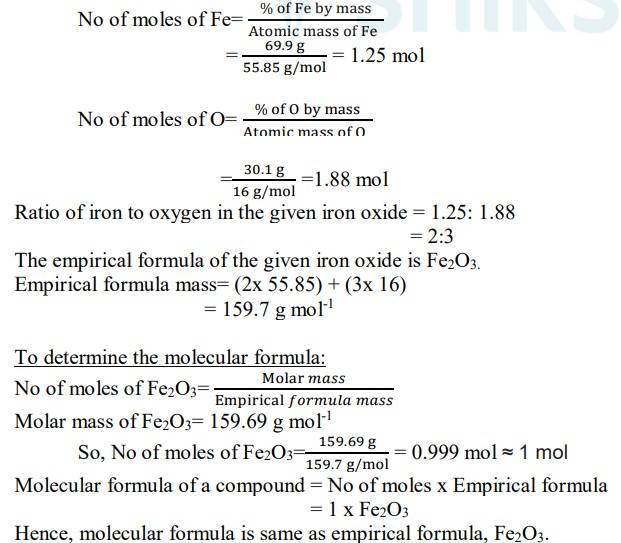Ncert Solutions Chemistry Class 11th
Get insights from 2k questions on Ncert Solutions Chemistry Class 11th, answered by students, alumni, and experts. You may also ask and answer any question you like about Ncert Solutions Chemistry Class 11th
Follow Ask QuestionQuestions
Discussions
Active Users
Followers
New answer posted
6 months agoContributor-Level 10
1.11. Molar mass of sugar = (12 x 12) + (22 x 1) + (11 x 16) =342 g/mol
No. of moles in 352 g of sugar = 1 mol
No. of moles in 20 g = 20 x 1/352 = 0.0585 mol
Therefore, molar concentration = moles of solute / volume of solution in L = 0.0585 / 2 = 0.0293 mol/L
New answer posted
6 months agoContributor-Level 10
Due to poor shielding effect of d-electrons in Ga, the electrons in gallium experience great force of attraction by nucleus as compared to Al. That is why Ga has lower atomic radius as compared to Al.
New answer posted
6 months agoContributor-Level 10
Because there is increase in atomic size on moving from carbon to silicon, the screening effect increases. Thus, the force of attraction of nucleus for the valence electron in silicon decreases as compared to carbon. Therefore, the ionization enthalpy decreases from carbon to silicon.
New answer posted
6 months agoContributor-Level 10
(i) Al reacts with conc. HNO3 to form a very thin film of aluminium oxide on its surface which protects it from further reaction. That is why conc. HNO3 can be transported in aluminium container.
2Al (s) + 6HNO3 (conc.) → Al2O3 (s) + 6NO2 (g) + 3H2O (l)
(ii) NaOH reacts with Al to evolve H2 gas. Thus, the pressure of the gas produced can be used for opening or cleaning clogged drains.
2Al (s) + 2NaOH (aq) + 2H2O (l) → 2NaAlO2 (aq) + 3H2 (g)
(iii) Graphite has layered structure which are held by weak van there Waals forces. Thus, graphite cleaves easily between the layers, therefore it is very soft and slippery. That is why
New answer posted
6 months agoContributor-Level 10
1.10. (i) 1 mole of C2H6 contains 2 moles of carbon atoms
Therefore, no of moles of C atoms in 3 moles of C2H6 = 6 moles
(ii) 1 mole of C2H6 contains 6 moles of hydrogen atoms
Therefore, no of moles of H atoms in 3 moles of C2H6 = 18 moles
(iii) 1 mole of C2H6 contains 6.02 x 1023 molecules
Therefore, 3 moles of C2H6 will contain ethane molecules = 3 x 6.02 x 1023 molecules= 18.06 x 1023 molecules
New answer posted
6 months agoContributor-Level 10
(a) Silicon is heated with methyl chloride at high temperature in the presence of copper catalyst at 537 K, methyl substituted chlorosilanes MeSiCl3, Me2→SiCl2→, Me3→SiCl and Me4→Si are formed.
(b) When silicon dioxide is treated with hydrogen fluoride, first SiF4→ is formed and then hydro fluorosilicic acid is obtained.
SiO2 →+ 4HF → SiF4 →+ 2H2→O
SiF4+2HF → H2SiF6
(c) When CO is heated with ZnO, ZnO is reduced to Zn metal.
CO + ZnO →CO2 →+ Zn
(d) When hydrated alumina is treated with aqueous NaOH solution, it dissolves to form sodium meta aluminate.
Al2→O3→.2H2→O+2NaOH→
New answer posted
6 months agoContributor-Level 10
1.9. Average atomic mass = (Fractional abundance of 35Cl x molar mass of 35Cl) + (Fractional abundance of 37Cl x molar mass of 37Cl)
= (75.77/100 x 34.9689) + (24.23/100 x 36.9659)
= 26.4959 + 8.9568
= 35.4527
New answer posted
6 months agoContributor-Level 10
(a) When borax is heated strongly, it loses water and swells into the white mass, which on further heating melts to form a transparent glassy solid called borax glass and borax bead.
Na2B4O710H2O→ Na2B4O7+ 10H2O
Na2B4O7 → 2NaBO2+ B2O3
(b) When boric acid is added to water, it accepts electrons from –OH ion. Boric acid is sparingly soluble in cold water however fairly soluble in hot water.
B (OH)3→ + 2H2→ O→ [B (OH)4→ ]→ + H3→ O+
(c) Al reacts with dilute NaOH to form sodium tetrahydroxoaluminate (III). Hydrogen gas is liberated in the process.
2Al + 2NaOH + 6H2O→ 2Na+ [Al (O
Taking an Exam? Selecting a College?
Get authentic answers from experts, students and alumni that you won't find anywhere else
Sign Up on ShikshaOn Shiksha, get access to
- 65k Colleges
- 1.2k Exams
- 679k Reviews
- 1800k Answers

